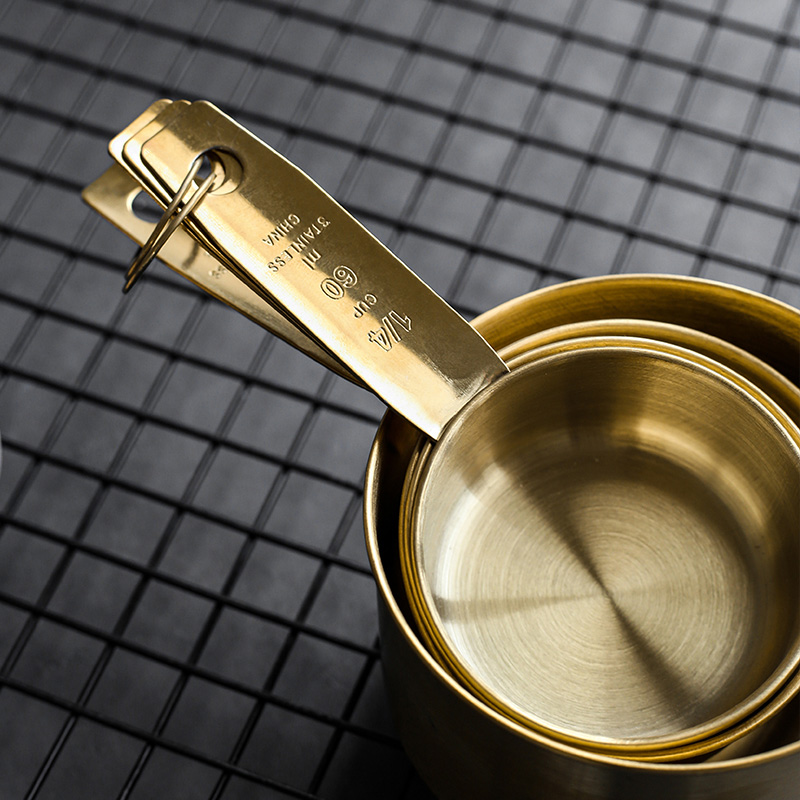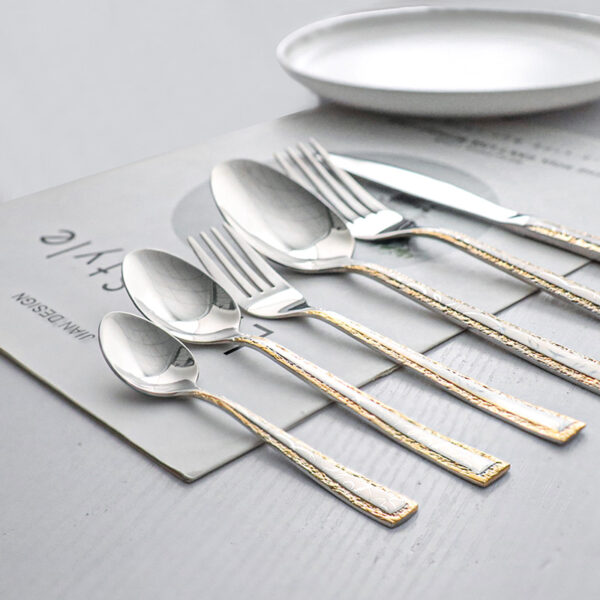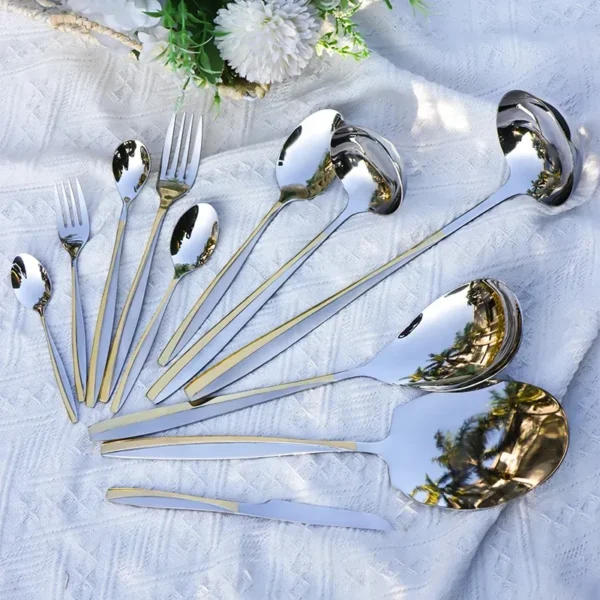Аннотация
Позолоченные столовые приборы не потускнеют. Эта декоративная элегантность делает ее весьма востребованной для украшения обеденных столов. Однако важно понимать различия в долговечности и уходе за разными типами золотая посуда. Для изготовления ножей из нержавеющей стали, серебряной или золотой пластины обычно используется один и тот же материал, известный как нержавеющая сталь 420. Этот тип стали чрезвычайно твердый и используется для предотвращения изгиба и сохранения острого края. В этой статье мы расскажем о природе золотых плоских изделий, потускнении различных материалов и правильном уходе за ними, чтобы ваши плоские изделия служили долго.
Оглавление
- Введение
- Понимание золотой посуды
- 2.1 Плоская посуда из чистого золота
- 2.2 Плоская посуда с золотым напылением
- Потускнеет ли золотая посуда?
- 3.1 Потускнение плоских изделий из чистого золота
- 3.2 Потускнение позолоченных плоских изделий
- Наука, лежащая в основе потускнения
- 4.1 Почему потускнели металлы
- 4.2 Факторы, влияющие на потускнение
- Сравнительный анализ золотых плоских изделий с другими материалами
- 5.1 Нержавеющая сталь
- 5.2 Плоская посуда с серебряным напылением
- Уход за золотой посудой
- 6.1 Техника очистки
- 6.2 Правила хранения
- Распространенные мифы о золотой посуде
- Заключение
Введение
Очарование золотая посуда Дело не только в его поразительной эстетике, но и в истории, мастерстве и способности возвышать обеденный стол. Для тех, кто ценит роскошь в повседневной жизни, золотые столовые приборы представляют собой захватывающую возможность создать красиво сервированный стол. Однако многие задаются вопросом, потускнеет ли золотая посуда. Этот вопрос очень важен для тех, кто собирается инвестировать в золотые столовые приборы, поскольку они хотят быть уверены, что их изделия останутся потрясающими и функциональными с течением времени.
В этой статье мы рассмотрим свойства золотых плоских изделий, выясним, все ли золотые плоские изделия тускнеют, и дадим рекомендации по уходу и обслуживанию, чтобы ваши изделия выглядели изысканно.

Понимание золотой посуды
2.1 Плоская посуда из чистого золота
Столовые приборы из чистого золота изготавливаются полностью из золота. Оно обычно выпускается в различных каратах, как правило, 14К или 18К. Массивное золото - это элитный выбор, который предпочитают за его долговечность, элегантность и престиж.
Характеристики столовых приборов из чистого золота:
- Нереактивный: Благодаря своей нереактивной природе чистое золото не тускнеет и не ржавеет. Благодаря этому качеству столовые приборы сохраняют свою красоту даже после постоянного использования и чистки.
- Долговечность: Цельное золото прочно и менее склонно к изгибам и поломкам по сравнению с другими материалами. Однако все же рекомендуется обращаться с ним осторожно.
- Роскошная привлекательность: Насыщенный цвет и блеск чистого золота придают неоспоримую элегантность любой сервировке стола, идеально подходящей для официальных ужинов и особых случаев.
2.2 Плоская посуда с золотым напылением
Позолоченные столовые приборы состоят из основного металла, обычно нержавеющей стали, на который нанесен тонкий слой золота. Толщина этого слоя может варьироваться, что влияет на долговечность и прочность изделий.
Характеристики позолоченной посуды:
- Экономичный вариант: Золотое покрытие обеспечивает визуальную привлекательность золота по значительно более низкой цене, чем чистое золото.
- Не тускнеющая поверхность: Хотя поверхность золота не потускнеет, под воздействием определенных условий основной металл может проявиться, если золотой слой сотрется.
Эстетическая гибкость: Позолоченные столовые приборы позволяют наслаждаться роскошным видом золота без высокой цены, что делает их популярным выбором для тех, кто стремится к стилю и элегантности во время трапезы.

Потускнеет ли золотая посуда?
3.1 Потускнение плоских изделий из чистого золота
Столовые приборы из чистого золота не тускнеют. Благодаря своей нереактивной природе золото остается неизменным внешне и не подвергается коррозии даже при контакте с различными продуктами питания или условиями окружающей среды. Это качество делает массивное золото идеальным выбором для тех, кто ищет долговечное и красивое дополнение к своей столовой коллекции. Вот несколько моментов, о которых следует помнить:
- Не тускнеющий характер: Поскольку золото - благородный металл, оно не вступает в реакцию с серой, воздухом или влагой, которые обычно способствуют потускнению других металлов.
- Долговечность: Столовые приборы из чистого золота способны выдержать суровые условия регулярного использования, сохранив при этом свою первоначальную красоту. Периодическая полировка поможет сохранить блеск, но сильное потускнение не вызывает опасений.
3.2 Потускнение позолоченных плоских изделий
Позолоченные столовые приборыНесмотря на то, что золото не портится в традиционном смысле, со временем на нем может появиться износ. Слой золота может поцарапаться или истончиться, обнажив основной металл, который может потускнеть. Вот что следует учитывать:
- Облучение основного металла: Если золотой слой стирается в результате многократного мытья, жестких методов очистки или взаимодействия с контактирующими металлами, основа из нержавеющей стали может начать тускнеть.
- Забота - это главное: Правильный уход и хранение могут значительно продлить срок службы золотого покрытия. Продуманная чистка и хранение помогут сохранить золотой слой и предотвратить потускнение основного металла.
Наука, лежащая в основе потускнения
4.1 Почему потускнели металлы
Потускнение происходит, когда металлы окисляются или реагируют с серой или влагой в воздухе, что приводит к обесцвечиванию. Именно поэтому некоторые металлы, например серебро, со временем приобретают потускневший вид. Золото, будучи благородным металлом, не окисляется и не вступает в подобные реакции, поэтому оно считается устойчивым к потускнению.
- Окисление: Эта химическая реакция происходит, когда металл вступает в реакцию с кислородом в окружающей среде. В случае с золотом он остается незатронутым.
- Химические реакции: Другие металлы могут вступать в реакцию с серосодержащими веществами, обычно содержащимися в продуктах питания или загрязняющими воздух, что приводит к потускнению.
4.2 Факторы, влияющие на потускнение
Несколько факторов могут повлиять на то, что позолоченные изделия начнут проявлять признаки износа:
-
Толщина золотого покрытия: Более толстые слои золота обеспечивают большую долговечность. При покупке позолоченных столовых приборов обращайте внимание на качество толщины покрытия.
-
Условия хранения: Влажность и температура могут повлиять на долговечность золотого покрытия. Хранение плоской посуды в сухом прохладном месте поможет свести к минимуму воздействие элементов, которые могут вызвать износ.
-
Частота использования: Регулярно используемые плоские изделия подвержены большему количеству возможных царапин и воздействию различных видов пищи, что может повлиять на золотой слой. Поэтому очень важно соблюдать осторожность при использовании и чистке.
-
Практика уборки: Абразивные чистящие средства и жесткие методы обработки могут повредить золотой слой, поэтому следует избегать использования стальной ваты или агрессивных моющих средств.

Сравнительный анализ золотых плоских изделий с другими материалами
5.1 Нержавеющая сталь
Нержавеющая сталь часто используется как в массивных серебряных, так и в позолоченных столовых приборах.
- Устойчивость к ржавчине: Нержавеющая сталь известна своей устойчивостью к ржавчине и пятнам, что делает ее популярным материалом для изготовления кухонных принадлежностей.
- Долговечность: Ножи, изготовленные из нержавеющей стали 420, отличаются твердостью и долговечностью и способны сохранять острую кромку без изгибов. Однако без надлежащего ухода нержавеющая сталь может со временем обесцвечиваться.
5.2 Плоская посуда с серебряным напылением
Посеребренные столовые приборы по эстетическим характеристикам схожи с золотыми, но со временем ведут себя по-другому.
- Потускнение: В отличие от золота, серебро тускнеет под воздействием воздуха и влаги, поэтому для сохранения блеска требуется регулярная полировка.
- Требования к уходу: Посеребренные столовые приборы требуют более тщательного ухода. Регулярная полировка необходима для предотвращения образования потускнения, а воздействие кислой пищи может усугубить потускнение.
- Эстетические различия: В то время как посеребренные столовые приборы обладают своим собственным шармом, золотые столовые приборы могут легко интегрироваться в более широкий спектр стилей декора, хорошо сочетаясь как с современной, так и с традиционной сервировкой стола.
Уход за золотой посудой
Правильный уход жизненно важен для сохранения красоты и долговечности как изделий из чистого золота, так и позолоченных столовых приборов. Вот некоторые рекомендации по чистке и хранению золотых столовых приборов:
6.1 Техника очистки
-
Ручная стирка: Всегда мойте золотые столовые приборы вручную теплой мыльной водой. Избегайте посудомоечной машины, так как высокие температуры и агрессивные моющие средства могут повредить золотой слой.
-
Используйте мягкое мыло: Выбирайте мягкое мыло для мытья посуды без добавок и абразивных веществ. Избегайте мыла с лимонной кислотой, так как оно может плохо взаимодействовать с золотыми покрытиями.
-
Мягкие ткани и губки: Мягкой губкой или тканью аккуратно очистите каждую деталь. Избегайте абразивных средств, которые могут поцарапать поверхность.
-
Ополаскивание и сушка: Тщательно промойте плоскую посуду в теплой воде, чтобы удалить все остатки мыла. Сразу же высушите изделия мягкой тканью без ворса, чтобы предотвратить появление водяных пятен и потускнения.
-
Периодическая полировка: Для плоских изделий из чистого золота периодическая полировка с помощью полироли для золота поможет вернуть им блеск. Тщательно следуйте инструкциям производителя, чтобы не повредить отделку.
6.2 Правила хранения
-
Специальное место для хранения: Храните золотые столовые приборы в специальном ящике или футляре с мягкой подкладкой, чтобы избежать царапин.
-
Используйте разделители: Если вы храните несколько предметов вместе, используйте разделители или мягкие валики, чтобы разделить их и минимизировать контакт, который может привести к царапинам.
-
Избегайте влажности: Убедитесь, что место хранения прохладное и сухое. Избыток влаги может повлиять как на золото, так и на основной металл позолоченных плоских изделий. Рассмотрите возможность использования силикагелевых пакетов для поглощения влаги в местах хранения.
-
Защита от других металлов: При хранении держите золотые столовые приборы подальше от другой металлической посуды. Контакт с другими металлами может привести к появлению царапин и потускнению основного слоя.

Распространенные мифы о золотой посуде
Несмотря на то, что золотые столовые приборы можно любить, существует несколько мифов, касающихся их использования и ухода за ними. Давайте развеем некоторые из этих заблуждений:
Миф 1: Позолоченная плоская посуда потускнеет так же, как и посеребренная
Правда: Позолоченные столовые приборы не потускнеют в традиционном смысле, поскольку золотой слой сам по себе не реагирует. Однако износ и воздействие основного металла могут привести к обесцвечиванию.
Миф 2: Золотые столовые приборы предназначены только для официальных мероприятий
Правда: Золотые столовые приборы придают элегантность официальным обедам, но многие семьи предпочитают использовать их и для повседневных трапез. Ежедневное использование золотой посуды может придать обычным блюдам особое звучание.
Миф 3: Все золотые столовые приборы созданы одинаковыми
Правда: Золотые столовые приборы значительно различаются по качеству, типу золотого покрытия и толщине. Важно искать изделия с хорошими отзывами и гарантией качества, особенно если вы рассматриваете варианты с позолотой.
Миф 4: Нельзя чистить золотую посуду
Правда: Золотые столовые приборы можно и нужно чистить, но для сохранения их красоты необходимо учитывать особые требования. Если вы будете использовать правильные методы чистки, она будет выглядеть наилучшим образом.
Заключение
На вопрос о том, портится ли золотая посуда, можно ответить, если четко понимать разницу между изделиями из чистого золота и позолоченными. Столовые приборы из чистого золота отличаются исключительной прочностью и устойчивостью к потускнению, что делает их отличным выбором для тех, кто хочет вложить деньги в долговечную элегантность. С другой стороны, позолоченная посуда, несмотря на свою красоту и доступность, может со временем износиться, если за ней не ухаживать должным образом, так как основной металл, лежащий в ее основе, может потускнеть, если подвергнуть его воздействию.
Понимание этих различий позволяет потребителям делать осознанный выбор в зависимости от их потребностей, предпочтений и бюджета. Правильная чистка, хранение и уход за золотыми столовыми приборами позволят вам наслаждаться их красотой долгие годы, делая каждый прием пищи роскошным.
Нестареющая привлекательность золотых столовых приборов
Помимо немедленного ответа на вопрос о потускнении, неизменная популярность золотых столовых приборов обусловлена их способностью улучшать впечатление от трапезы. Принимаете ли вы друзей за обычным ужином или празднуете торжественное событие, золотые столовые приборы придают обстановке элегантность и вносят художественный штрих в сервировку стола.
В то время как тренды приходят и уходят, золотые столовые приборы не теряют своей актуальности, адаптируясь к меняющимся стилям декора и сохраняя при этом свой классический шарм. Для многих инвестиции в качественную золотую посуду - это не только эстетика, но и создание неизгладимых воспоминаний за красиво сервированным обеденным столом.
Заключительные размышления
Приобретая и ухаживая за золотыми столовыми приборами, помните, что понимание материалов и правильного ухода за ними - это ключ к сохранению их красоты и функциональности. Независимо от того, выбираете ли вы цельное золото или позолоченные варианты, правильный выбор обеспечит, что ваша столовая посуда станет ценной частью вашего обеденного опыта.
Развеяв мифы, устранив общие опасения и приняв гламурную природу золотых плоских изделий, вы сможете уверенно привнести элегантный стиль в свой дом.






